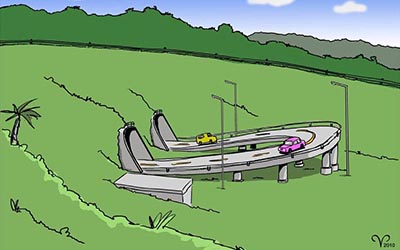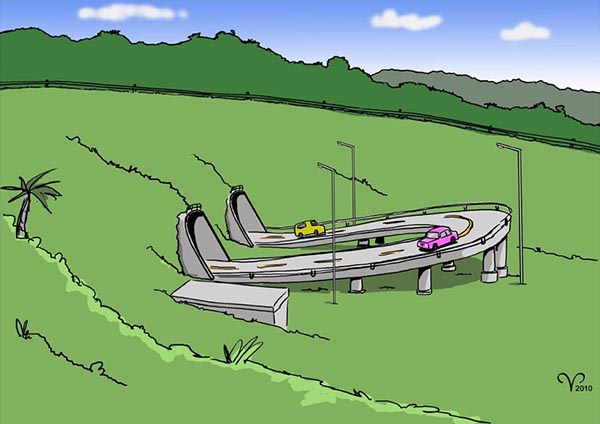Safety first trumps weak economics


Stop the Motorway #1: Reduce development pressure on Mahurangi West and Pūhoi, and drastically improve safety in the Dome Valley. cartoon Majorlook Productions
A good deal of sense was talked in Auckland and Wellington yesterday.
Auckland Regional Council listened to two options that put safety first, in quickly and affordably upgrading the dangerous highway between Pūhoi and Wellsford motorway, presented by the Campaign for Better Transport.
In parliament, Labour transport spokesman Darren Hughes again criticised the proposed $2.3 billion Pūhoi–Wellsford motorway. Mr Hughes has delighted New Zealanders with his member’s bill that would drop drivers’ blood–alcohol limit from .08 to .05 grams of alcohol per 100 millilitres of blood.
Predictably, the Mayor of Rodney’s media folk rushed out a statement emphasising Mrs Webster’s disappointment. The indignant tone was spoiled somewhat by the project’s cost being referred to as ‘$100 million-plus’ when she/they presumably meant $1000 million-plus.
As it happens, $100 million-plus—$160 million, to be fair—is all that the Campaign for Better Transport believes it would cost to drastically reduce fatalities on the highway between Pūhoi and Wellsford, below the 41 that occurred 2000–2009.
Following the presentation, the regional council issued a media release stating it remained unconvinced of the need for a new motorway and asking the NZ Transport Agency to introduce more pressing safety improvements. Regional councillor Christine Rose:
Our message is clear: Safety must be the NZ Transport Agency’s top priority when it comes to State Highway 1.
Lives must be saved through a timely and cost-effective response to the current safety and reliability challenges.
We are confident that immediate improvements can be made between Pūhoi and Wellsford to enhance safety and reliability now, without the cost of building a new motorway.
Mrs Webster, meantime, claims that the motorway:
…is important for the economic future of Rodney, Northland and Auckland as a whole.
But that claim is weak. The 2008 SH1/16 Auckland to Wellsford Strategic Study prepared by SKM for the transport agency included regional economic impact:
5.9.1 Regional Economic Impacts
Within the initial evaluation framework, the relative effects of strategy options for the state highway network were considered. Further work was undertaken to assess the potential magnitude of implementing the strategy on the regional economy. The key conclusions that arose from this assessment were:
- The economy of Northland is relatively weak with low regional GDP per capita and a low historic growth rate.
- The economy has a relatively high concentration of activities in the agriculture and natural resources sectors, areas where key demand may lay overseas rather than elsewhere in New Zealand. For this traffic, interactions with Auckland may decline with the development of port facilities at Marsden Point and the construction of a connecting rail link.
- The key centre in Northland is Whangārei, which is at a considerable distance from the main centres in the Auckland region. The areas south of Whangārei are relatively lightly developed containing 10–15 percent of total regional employment, and the scope for substantial economic growth the upgrading of State Highway 1 is limited.
- The activity most likely to benefit from the improvement of State Highway 1 to Wellsford is tourism. However, this is relatively small scale in the areas of Northland with a contribution to GDP of about $30–50 million. Even if a significant contribution would be modest when set against the likely costs of road upgrading.
Therefore, regional economic issues are likely to make a significant contribution to the viability for implementing the strategy. However, it is clear that the strategy would make an overall contribution to the region.
As would an option costing much less, capable of being implemented much sooner.
Mahurangi: A marvelous place to stop the motorway.
